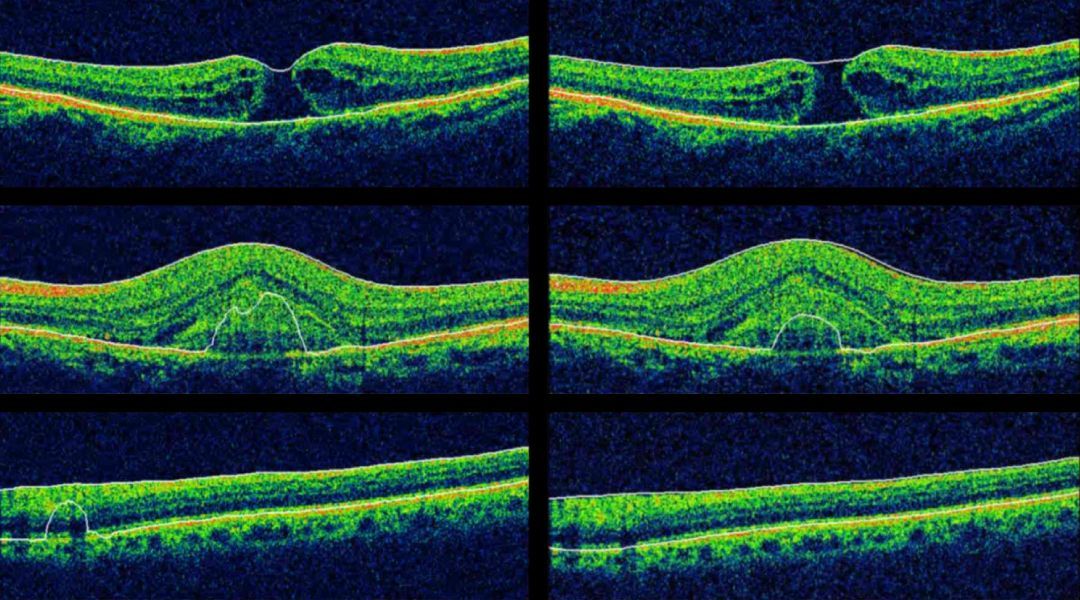Unlocking Eye Health: The Power of Digital Imaging in Advanced Eye Exams at Urban Optiks Optometry

Read time: 3 minutes
Cool picture, right? This cross-sectional image of the layers of the retina was captured during one of the digital imaging tests available at Urban Optiks Optometry. In the dynamic world of optometry, advancements in technology have ushered in a new era of precision and early detection.
Learn how Urban Optiks Optometry is at the forefront of this optical revolution and how your exam experience is enhanced by our use of state-of-the-art digital imaging technologies, such as retinal photography and Optical Coherence Tomography (OCT). See how these two screenings are integrated into the examination process, providing our doctors unparalleled insights into your eye health.
Understanding Digital Imaging
Retinal Photography
This sophisticated technique captures high-resolution images of the retina, the light-sensitive tissue lining the back of the eye. Through this non-invasive process, the doctor gains a detailed view of the blood vessels, optic nerve, and other crucial structures, aiding in the identification of potential issues before symptoms manifest.
Optical Coherence Tomography (OCT)
OCT takes imaging to a microscopic level, using light waves to create cross-sectional images of the retina. This allows for a more comprehensive analysis of the layers of the retina, helping detect subtle abnormalities that might go unnoticed with traditional methods.
Conducting the Tests
The testing process is quick and painless, and takes less than a minute per eye. The patient will be asked to place their chin on a chin rest and forehead against a support bar on the device to keep their head steady. The doctor then adjusts the patient's head and the device to ensure the most accurate images are achieved.
- For the retinal photography portion, the patient looks straight ahead and will see a bright flash, which is the camera taking a "picture", capturing high-resolution images of the retina.
- During the OCT test, the patient looks straight ahead at a green "X" surrounded by red light. While the patient holds still, the device will perform several scans of the eye without any physical contact, producing digital results as shown in the picture above.
The non-invasive and quick nature of these tests ensures minimal discomfort while delivering maximum diagnostic accuracy. Moreover, the digital imaging process eliminates the need for dilation during exams, enhancing patient comfort and convenience.
To learn more about the digital photography/OCT device, called the Topcon Maestro 2, or to see all of the other technology utilized during our exams, visit our technology page.
Deciphering Results for Holistic Health
The results obtained from digital imaging serve as a window into not just ocular health but also broader systemic well-being. Urban Optiks emphasizes that many warnings about whole-body health can be detected very early in the eye. Conditions such as diabetes, hypertension, and even cardiovascular issues often leave telltale signs in the eyes, making early detection paramount.
Digital Imaging: A Year-by-Year Record
One standout feature of digital imaging is its ability to create a comprehensive digital record of each year's results. This record becomes invaluable in detecting, monitoring, and treating various eye conditions. Moreover, it acts as a safeguard, allowing for the swift identification of emergency situations that could result in immediate vision loss.
Investing in Early Detection for Long-Term Benefits
While most vision plans may not cover the full cost and spectrum of digital imaging, our doctors emphasize the importance of opting to include these screenings in your examination to ensure the most thorough and comprehensive detection and diagnosis. The long-term benefits of early detection far outweigh the small cost of a co-pay or the out-of-pocket expenditure.
The Crucial Role of Annual Comprehensive Eye Exams
Urban Optiks underscores the importance of annual comprehensive eye exams as a proactive measure in maintaining eye health. The integration of digital imaging into these exams ensures a thorough assessment, offering a level of detail and insight beyond conventional methods. Regular exams with digital imaging can catch potential issues in their infancy, allowing for timely intervention and prevention.
The Takeaway
The adoption of digital imaging technologies at Urban Optiks Optometry represents a leap forward in comprehensive eye care. The fusion of retinal photography and OCT not only elevates the accuracy of diagnosis but also positions the practice at the forefront of preventive healthcare.
To experience the benefits of cutting-edge digital imaging and secure the future of your eye health,
book your appointment with Urban Optiks Optometry today. Your vision deserves nothing less than the best.
Share this blog post on social or with a friend:
The information provided in this article is intended for general knowledge and educational purposes only and should not be construed as medical advice. It is strongly recommended to consult with an eye care professional for personalized recommendations and guidance regarding your individual needs and eye health concerns.
All of Urban Optiks Optometry's blog posts and articles contain information carefully curated from openly sourced materials available in the public domain. We strive to ensure the accuracy and relevance of the information provided. For a comprehensive understanding of our practices and to read our full disclosure statement, please click here.


















